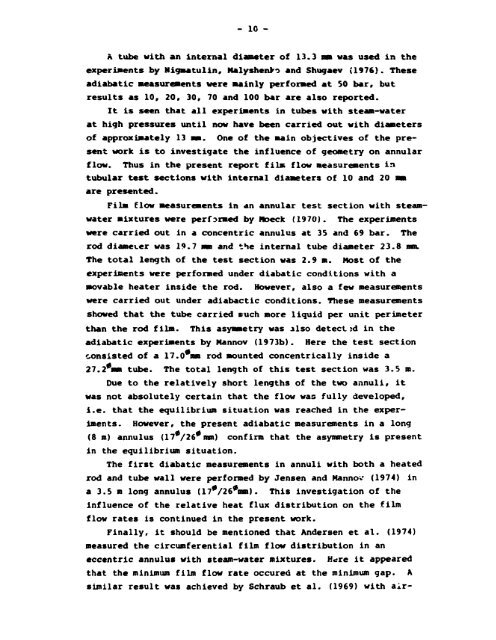An Experimental and Theoretical £ Investigation of Annular Steam ...
An Experimental and Theoretical £ Investigation of Annular Steam ...
An Experimental and Theoretical £ Investigation of Annular Steam ...
Create successful ePaper yourself
Turn your PDF publications into a flip-book with our unique Google optimized e-Paper software.
- 10 -<br />
A tube with an internal diameter <strong>of</strong> 13.3 mm was used in the<br />
experiments by Nigmatulin, MalyshenVo <strong>and</strong> Shugaev (1976). These<br />
adiabatic measurements were mainly performed at 50 bar, but<br />
results as 10, 20, 30, 70 <strong>and</strong> 100 bar are also reported.<br />
It is seen that all experiments in tubes with steam-water<br />
at high pressures until now have been carried out with diameters<br />
<strong>of</strong> approximately 13 am. One <strong>of</strong> the main objectives <strong>of</strong> the present<br />
work is to investigate the influence <strong>of</strong> geometry on annular<br />
flow. Thus in the present report film flow measurements in<br />
tubular test sections with internal diameters <strong>of</strong> 10 <strong>and</strong> 20 mm<br />
are presented.<br />
Film flow measurements in an annular test section with steamwater<br />
mixtures were perfarmed by Noeck (1970). The experiments<br />
were carried out in a concentric annulus at 35 <strong>and</strong> 69 bar. The<br />
rod diameier was 19.7 mm <strong>and</strong> the internal tube diameter 23.8 mm.<br />
The total length <strong>of</strong> the test section was 2.9 m. Most <strong>of</strong> the<br />
experiments were performed under diabatic conditions with a<br />
movable heater inside the rod. However, also a few measurements<br />
were carried out under adiabactic conditions. These measurements<br />
showed that the tube carried such more liquid per unit perimeter<br />
than the rod film. This asymmetry was also detect id in the<br />
adiabatic experiments by Hannov (1973b). Here the test section<br />
consisted <strong>of</strong> a 17.0 mm rod mounted concentrically inside a<br />
27.2*mm tube. The total length <strong>of</strong> this test section was 3.5 m.<br />
Due to the relatively short lengths <strong>of</strong> the two annuli, it<br />
was not absolutely certain that the flow was fully developed,<br />
i.e. that the equilibrium situation was reached in the experiments.<br />
However, the present adiabatic measurements in a long<br />
(8 m) annulus (17 0 /26*mm) confirm that the asymmetry is present<br />
in the equilibrium situation.<br />
The first diabatic measurements in annuli with both a heated<br />
rod <strong>and</strong> tube wall were performed by Jensen <strong>and</strong> Nannov (1974) in<br />
a 3.5 m long annulus (17*/26*mm). This investigation <strong>of</strong> the<br />
Influence <strong>of</strong> the relative heat flux distribution on the film<br />
flow rates is continued in the present work.<br />
Finally, it should be mentioned that <strong>An</strong>dersen et al. (1974)<br />
measured the circumferential film flow distribution in an<br />
eccentric annulus with steam-water mixtures. Kere it appeared<br />
that the minimum film flow rate occured at the minimum gap. A<br />
similar result was achieved by Schraub et al. (1969) with air-
















